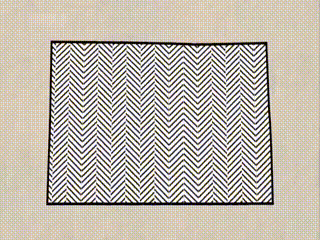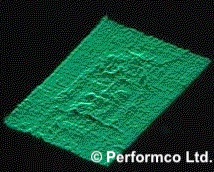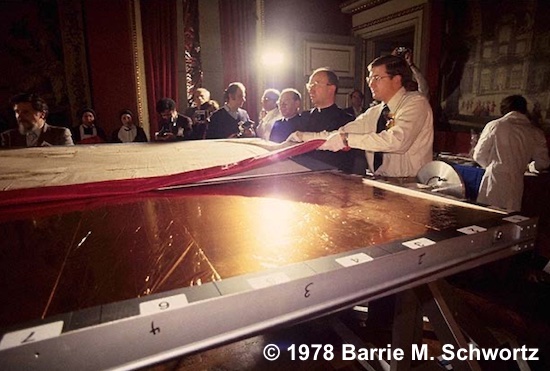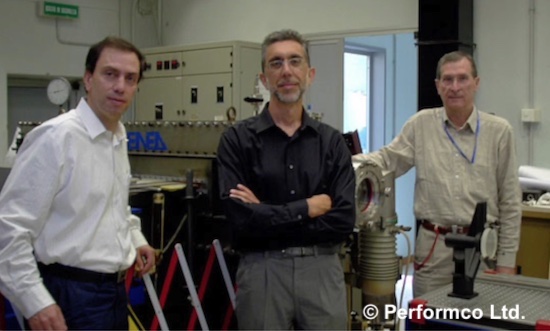
Who Can He Be?
The Shroud Image
The extraordinary image seen on the Shroud continues to defy science. During the past century, several scientists have had the opportunity to examine the image in detail in an attempt to understand how it was formed. However, no-one has yet been able to explain how the image was created and despite many attempts, no-one has been able to produce an image with the characteristics of the image of the Man of the Shroud.
The Faint Image
Those people who are fortunate enough to have closely examined the Shroud agree that whilst the faint image of the Man of the Shroud is visible from a distance, the markings cannot be seen when viewed at close quarters. In the words of author Ian Wilson, “The closer one tries to examine them, the more they seem to melt like the mist.”.
A microscopic examination of threads from the image areas of the Shroud reveals a number of fascinating characteristics.
- The markings are caused by extremely superficial yellowing of the surface of the fabric.
- There are no colour changes in the threads other than in topmost two or three fibres and the discolouration only affects the external cell wall of these fibres.
- The hue of the discoloured fibres doesn’t change: it is the same in both the light and dark shaded areas. The variation in shade intensity is instead caused by differences in the number of yellowed fibres present in a given area.
- No discoloured fibres have been found beneath the bloodstains on the Shroud, which indicates that the bloodstains must have been present when the image was formed.

© Performco Ltd.
The image is formed by discolouration of the surface fibres in the fabric
The Photographic Negative

Ever since the Shroud was photographed for the first time in 1898, people have been fascinated by the photographic negative image. The light and dark areas are reversed, revealing an unusually realistic perfection which has so far proved impossible for artists to replicate. Indeed, a British artist and agnostic named John Weston became convinced of the Shroud's authenticity after attempting to produce, tone by tone, a duplicate Shroud for the film The Silent Witness.
The 3-D Effect
Another unique feature of the Shroud image was discovered in 1976 when it was scanned by Dr. John Jackson and Dr. Eric Jumper using a VP-8 Image Analyzer. This is an instrument which is able to convert a two-dimensional black and white image into a three-dimensional representation, by generating a vertical relief profile based upon the intensity of shading on the image. When this device was used with photographs or paintings, the result was a distorted and inaccurate representation of the original image. However, the Shroud image produced an accurate three-dimensional representation of the Man of the Shroud, with facial features, arms, legs and chest all contoured correctly. The two scientists later demonstrated this to Peter Schumacher, the inventor of the device. He later recalled his astonishment:
I had never heard of the Shroud of Turin before that moment. I had no idea what I was looking at. However, the results are unlike anything I have processed through the VP-8 Analyzer, before or since. Only the Shroud of Turin has produced these results from a VP-8 Image Analyzer isometric projection study. Peter Schumacher

The VP-8 image of the Shroud Face
STURP Image Investigations

Moving the Shroud to the STURP Examination Table
The primary purpose of the 1978 STURP examination was to determine the scientific properties of the image on the Shroud of Turin, and what might have caused it. They were able to examine the Shroud for five days, during which they also took numerous X-Ray, Ultraviolet and natural light photographs and obtained surface samples by pressing adhesive tape onto the surface of the Shroud. After three years of studying all the data which they had collected, they published their report conclusions.
"No pigments, paints, dyes or stains have been found on the fibrils. X-ray, fluorescence and microchemistry on the fibrils preclude the possibility of paint being used as a method for creating the image. Ultra Violet and infrared evaluation confirm these studies. Computer image enhancement and analysis by a device known as a VP-8 image analyzer show that the image has unique, three-dimensional information encoded in it. Microchemical evaluation has indicated no evidence of any spices, oils, or any biochemicals known to be produced by the body in life or in death. It is clear that there has been a direct contact of the Shroud with a body, which explains certain features such as scourge marks, as well as the blood. However, while this type of contact might explain some of the features of the torso, it is totally incapable of explaining the image of the face with the high resolution that has been amply demonstrated by photography.
The basic problem from a scientific point of view is that some explanations which might be tenable from a chemical point of view, are precluded by physics. Contrariwise, certain physical explanations which may be attractive are completely precluded by the chemistry. For an adequate explanation for the image of the Shroud, one must have an explanation which is scientifically sound, from a physical, chemical, biological and medical viewpoint. At the present, this type of solution does not appear to be obtainable by the best efforts of the members of the Shroud Team. Furthermore, experiments in physics and chemistry with old linen have failed to reproduce adequately the phenomenon presented by the Shroud of Turin. The scientific concensus is that the image was produced by something which resulted in oxidation, dehydration and conjugation of the polysaccharide structure of the microfibrils of the linen itself. Such changes can be duplicated in the laboratory by certain chemical and physical processes. A similar type of change in linen can be obtained by sulfuric acid or heat. However, there are no chemical or physical methods known which can account for the totality of the image, nor can any combination of physical, chemical, biological or medical circumstances explain the image adequately.
Thus, the answer to the question of how the image was produced or what produced the image remains, now, as it has in the past, a mystery.
We can conclude for now that the Shroud image is that of a real human form of a scourged, crucified man. It is not the product of an artist. The blood stains are composed of hemoglobin and also give a positive test for serum albumin. The image is an ongoing mystery and until further chemical studies are made, perhaps by this group of scientists, or perhaps by some scientists in the future, the problem remains unsolved."
The investigation had achieved a notable success as it had confirmed that the image on the Shroud wasn’t the work of an artist. Unfortunately however, it failed to unlock the mystery of how the image had been formed.
Reproducing the Image Characteristics
One group of scientists have attempted to reproduce one of the unusual characteristics of the Shroud image. A team of Italian scientists led by physicist Paolo di Lazzaro succeeded in producing the same highly-superficial discolouration of linen fibres using Excimer Lasers. This was achieved by directing short, high-energy pulses of ultraviolet light at a small, one square centimetre sized sample of linen fabric. They calculated that to scale this up to a Shroud-sized linen cloth would require pulse durations of less than one forty-billionth of a second and intensities of the order of several billion watts!

Paolo di Lazzaro and colleagues
Performco Ltd. Town Hall, Penn Road, Beaconsfield, Bucks HP9 2PP
Copyright © Performco Ltd.